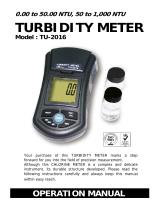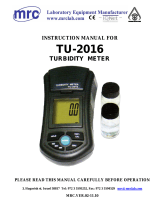
MICRO 200 BW 0-10 & 0-100 NTU (05/05)
Rev. 3.4
2.0 INSTALLATION
2.1 PACKING LIST FOR THE MICRO 200 BW
CONTENTS QUANTITY
Instruction Manual 1
MICRO 200 BW Instrument 1
Desiccant Tray Assembly 1
50125A Tubing Kit - includes: 1
-Shutoff clamp
-Backpressure Valve
-Connecting tubing with fittings for
flow-through assembly
-Drain Vent Screw
(only required for pressurized system)
Accessory kit - includes:
-0.02 NTU calibration standard 1
-Spare flow through cuvette 1
-Light Shield Cap 1
A listing of recommended spare parts appears on page
32 of this manual.
2.2 UNPACKING AND INSPECTION
Use extreme care when unpacking your MICRO 200
BW and note that all of the contents are included. Check
for any damage that may have occurred during shipping.
If there are any omissions, report this immediately to the
your local distributor or the Quality Assurance Dept. at
HF scientific, inc. If there is any shipping damage;
notify the shipping company immediately and arrange
for a prompt inspection.
2.3 MOUNTING
CAUTION: Instrument is not designed for outdoor
installation. The LCD screen will be dam-
aged by UV rays. Contact factory for avail-
able enclosures.
The maximum allowable ambient temperature is 122°F
(50°C).
NOTE: Be careful during installation not to violate the
moisture integrity of the sensor, interface or
analyzer housings. The analyzer requires ap-
proximately two hours to reach its final operat-
ing temperature. Further adjustment of the
LCD brightness may be required during this
period.
2.3.1 Analyzer
The location of the analyzer should be given careful
consideration. As an example, if the MICRO 200 BW is
to be used for performing backwash, the analyzer must
be mounted where it can be viewed at the backwash
control station. In this example, for convenience of
maintenance, the turbidity sensor should be mounted at
the backwash station and have the water plumbed to it.
The analyzer must be mounted in a location that avoids
direct water contact. Refer to figure 2 for outline dimen-
sions. Allow enough room for the analyzer to pivot on
the mounting bracket upside down, to make connec-
tions.
After mounting, the angle of analyzer may be adjusted
for best visibility.
2.3.2 Sensor - Turbidity
For the outline drawing of the turbidity sensor refer to
figure 3 on page 7. Allow enough room for easy access
to both the flow through unit and the lamp module.
Avoid mounting the sensor in a location that will put the
sensor housing in contact with dripping water, as this
will present problems when performing periodic main-
tenance.
The sensor is equipped with a foot valve, that opens in
case the flow through cuvette ruptures, to prevent dam-
age to the sensor. The foot valve drain tube can be
connected to a 5/8" (15.9 mm) tube (not supplied) to
direct the flow of water to a convenient drain. Keep the
length of this external tube to a minimum.
CAUTION: The foot valve system will handle up to 1
gallon per minute. Flow rates higher than
this will cause the sensor to flood.
2.3.2.1 Installing & Replacing Pack Desiccant Tray
Before operating the Micro 200BW for the first time
the replaceable desiccant pouch must be installed.
Please refer to Figure 1 (page 9) while installing for
the first time. To initially install, unscrew the four
thumbscrews and remove the electronics half of the
sensor. Open the bag and remove the dessicant pouch
and the indicator card. Install these items and replace
the top portion of the sensor.
Proper use of the supplied desiccant is essential in
maintaining the performance of the instrument. The
desiccant pouch is designed to have a long life;
Page 6





















